If you are like millions of people across America, seasonal plant allergies are probably a dreaded aspect of the changing seasons.
While we can be allergic to everything from cats to coriander, one allergy is so common that most people immediately feel the burning, itching, and sneezing it brings each season.
Almost 25 million people in America suffer each year thanks to ragweed, which causes them to battle a runny nose, itchy eyes, endless sneezing, and labored breathing.
Unfortunately, almost 20 variations of this plant can be found in 49 of the 50 United States, with Alaska being the only state in which it does not grow.
Two types of ragweed are typically encountered in North America, common ragweed and giant ragweed.
What Is Ragweed?
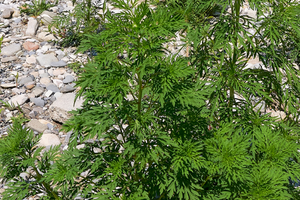 Ragweed is a common plant that emerges in the spring and sets seeds in the late summer/fall.
Ragweed is a common plant that emerges in the spring and sets seeds in the late summer/fall.
Found growing in shallow soils across the U.S., North America, and throughout Europe, the ongoing and often invasive spread of ragweed is fueled by climate change.
Related: 7 Foraging Mistakes That Might Get You Killed
Its pollen is notoriously known for causing allergic reactions. It is thought that more than half the pollen-related allergic rhinitis (hay fever) results from various types of ragweed growing worldwide.
The most widespread variant of this annoying plant is the common ragweed, also known as Ambrosia artemisiifolia.
Identification
Ragweed can be challenging to identify due to the many variations found worldwide. Common ragweed can remain mere centimeters or tower to more than four feet tall.
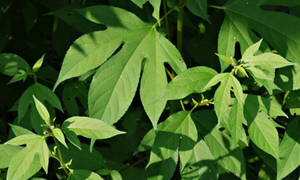 The leaves of a ragweed plant are as diverse as the plant itself and can be found growing alternately, oppositely, or both.
The leaves of a ragweed plant are as diverse as the plant itself and can be found growing alternately, oppositely, or both.
The giant ragweed species has palmate leaves, meaning the leaves look like the palm of a hand.
While the leaves of giant ragweed generally have serrated edges, this is not always the case.
On the other hand, common ragweed has leaves that are made up of multiple smaller leaves. The common ragweed leaves are more fern-like and are referred to as twice, or double compound leaves.
Related: 11 Dangerous Plants You Should Never Have In Your Backyard
Among the standard variety, the leaves of the common ragweed generally remain more diminutive in size. Common ragweed leaves usually grow to around 6 inches long and 4 inches across.
The stem of a ragweed plant can also differ depending on the type and location of the weed, but they generally form to become a flower spike which allows them to quickly release seeds at the end of their seasonal cycle.
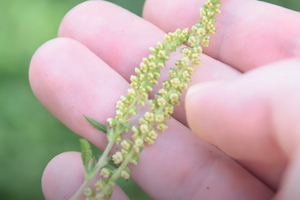 Ragweed plants flower to produce and spread seeds.
Ragweed plants flower to produce and spread seeds.
The flowers of the ragweed plant are said to be inflorescence, a small cluster arranged on a stem. The tiny blossoms may go unnoticed by gardeners, who overlook them due to their appearance as small, yellowish bumps.
The flowers of a ragweed plant do not look like flowers at all; they are small and spherical, appearing more like tiny buds than flowers. These flowers form a spike at the top of the stem on male plants and are tightly packed together throughout the branches and leaves on female plants.
Imposter Plants
Due to the vast varieties of ragweed and its inconspicuous appearance, this plant is often confused with other weeds.
⇒ Learn How To Tell Apart Edible Plants And Their Poisonous Lookalikes
Mayweed chamomile, for example, has the same fern-like foliage. However, mayweed chamomile is much smaller than a ragweed plant, forms a basal rosette (a cluster of leaves arranged in a circle all of the same height), and has a daisy-like flower.
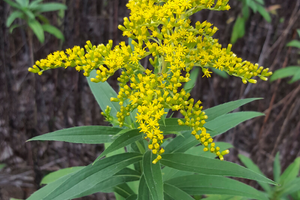 Goldenrod is also mistaken for ragweed quite often.
Goldenrod is also mistaken for ragweed quite often.
This plant, however, is good for the garden as it entices insects and encourages crop growth.
Still, if you are allergic to goldenrod, it can cause a great deal of discomfort.
Ragweed Allergies
A common allergy for many people, ragweed pollen, is a dreaded signal that the end of summer has arrived. A single ragweed plant can produce more than a billion pollen grains per season.
This pollen can significantly impact millions who suffer from a ragweed allergy. Pollen from the ragweed plant is transported through the air with the wind and is a leading cause of hay fever.
Those who battle ragweed allergies report a variety of symptoms, including stuffy or runny nose, itchy eyes, sneezing, and trouble breathing.
Ragweed, especially the common variety, is resistant to removal.
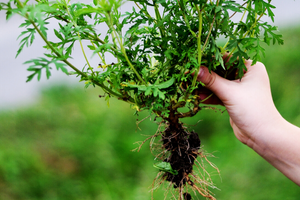
The ragweed plant is resistant to most pesticides, and removal must be done manually early in the season.
Avoiding ragweed is often impossible as it is an everyday staple of our ecosystem. While you may be unable to avoid this dreaded plant, you can limit exposure during peak problem periods.
During ragweed season, which begins in early August and runs until mid-to-late October, some things can help you cope with your allergy to ragweed.
Combatting Ragweed Allergies
The pollen of a ragweed plant can travel more than 2 miles into the atmosphere and more than 400 miles out to sea.
• Track Local Pollen Counts:
Most weather reports and apps provide a pollen index that tells users when pollen counts are high. On days when the pollen levels are high, try to stay inside the house as much as possible.
• Avoid Peak Ragweed Hours:
The peak period for ragweed pollen is between 10 a.m. and 3 p.m., with counts being lower in the morning and late in the afternoon. Try to avoid outdoor exposure during these peak periods.
• Close Windows And Doors:
Keep your windows closed when you are at home or in the car. Use air conditioning to keep cool, and ensure that it has a HEPA filter installed to limit the entrance of outside pollutants into your home.
• Wash Your Hands:
Washing our hands should be second nature at this point. Regularly cleaning your hands can help alleviate your allergy symptoms and protect you from germs and bacteria.
• Wipe Down Surfaces:
Like washing your hands, cleaning surfaces you interact with can help limit your contact with ragweed and other allergens.
• Change Your Clothes:
The pollen of the ragweed plant is fine and can easily stick to clothing to be carried into your home. Changing your clothes after spending time outdoors can help to combat an allergic reaction.
• Do Not Use Your Clothesline:
While hanging clothes out to dry can be a pleasant experience, you want to avoid doing this during ragweed season if you have allergies – dry clothes indoors instead of hanging them on a clothesline to limit your pollen exposure.
Ragweed is a pesky plant that causes hay fever in millions each year. While it can be impossible to avoid ragweed entirely, knowing what it looks like, where it grows, and how it spreads can help to ease suffering.
If you suffer from a ragweed allergy, consider taking over-the-counter antihistamines during peak allergy season. Many people begin taking medications two weeks before ragweed season starts. Check with your doctor to create a plan of action.
Alternatively, you can try treating your ragweed allergy naturally at home. Many natural options for treating ragweed allergies exist.
Most importantly, limit your exposure to the pollen of the ragweed plant as much as possible. Thus, if you find ragweed growing in your garden, do not smell it.






















I’m not German, and thus am genetic soup, and allergic to everything. Being Aussie it’s not just the animals trying to kill me, I’m allergic to pretty much everything vegetation too. Eucalyptus. Tea Tree. Aloe. Acacia. Melaleuca. Grass. Every. Horrid. Type. Of Grass.
There’s other ways to manage severe environmental allergies – the pandemic brought the average human “air filters”. Use them, and a lot.
Live above the pollen layer – move up off the street level and well above the tree canopy.
Learn which plants you are actually allergic to, oddly I am fine with Plane trees – something every one else seems to be reactive to. Identifying your own allergens can help you work out what the issues are.
Work with an immunologist to desensitise common pollens – it’s a slow process but there’s moderate success. Also discuss doing a multi month run of simple antihistamines to get relief.
Learn how to manage allergic rhinitis and swollen sinus issues. Dramatic improvements in day to day health can result, including a reduction in sleep apnea or snoring, less sinus infections, less hearing issues and so on. (And no, saline baths alone are not the answer, and if it’s pollen you could just be pushing it further up into your sinus cavity, so you need to sort out what YOUR issue is, with medical advice from a doctor.)
Barriers are great. Face masks are awesome in high pollen days (good ones), and if you are skin reactive (heaven help me, I am sometimes!) then long sleeves and trousers.
Keep an ear out for chainsaws, leaf blowers and other noisy neighbours that are stirring all this crap up. Close your windows.
Consider staying somewhere else for a few days to give your body a break.
When you know which plants you are allergic to you can manage them in your immediate environment. Do the skin prick testing… because that Boronia sure is pretty but it’s the reason my skin peels off my face! And the Golden Wattle is amazing but it’s why I have hives and welts over most of my body.
Naw. The German comment was about someone saying they had strong genes… and I was making tongue in cheek fun of that. But it seems to be deleted? NEver mind. And I’ve just realised that it could be a ?fascist? Reference… I’m obtuse to that stuff encountering it so rarely in West Australia, sorry! Please scroll on past that bit! Lesson learnt here!
Have you tried adding local honey to your diet. I did this several years ago and am practically allergy free. Very few sniffles in the fall. Hope all works out for you???
I’ve heard this works for general hayfever quite well Rodney, and it’s recommended by many allergists.
Mine isn’t purely a pollen allergy, and it goes beyond hay fever – mine is a full blown allergic reaction.
But yes, I might supplement more local honey and see if it can help with the hay fever side of things. (I actually have a kid allergic to actual honey, weird but happens, so we have several jars of real and ‘fake’ every year for testing purposes. Did you know a huge amount of the honey on supermarket shelves is synthetic? And it’s actually near impossible to tell apart from refined ‘real’ honey? Fascinating Sunday morning read if you want to google ‘real vs fake honey’ and “honey economy”.
looks like they have issues with free speech here.
Too bad they don’t do anything about all the trolls that show up daily and waste everyone’s time and drive off people that can contribute here.
Certain things are deleted in place because evil people in disguise hate the truth, not to mention, free speech. It’s an Obama trait. Can’t fix stupid, …just have to move on to other areas of similar topics
“An Obama trait”… And YOU are worried about trolls? OK Boomer.
Thank you for reminding us re: allergies. I’ve been so distracted with all the c**p going on and just trying to work and take care of everything. Thank you for the pic of ragweed as well. I usually only have a small allergy once a year, in the fall evening … but for the past 3 years, I’ve had allergies all year long. It’s miserable. And for a laugh y’all … considering an above comment, I’m half German. It hasn’t helped. Lol.
Right. And If you see a Weed in your yard that has 7 seratted leaves and flowers that smell like diesel fumes and sour oranges, well, you better smoke it. Or extract its oil and save it for armageddon.
LOL. Just make sure you don’t have more than the legal limit for your area….
I was the 1st person ever to be allergic, it wasn’t until around 1980 everybody else started having problems. I’m allergic to everything, been a mouth breather all my life. Synthetic fabrics burn my skin and break me out in hives. I love peppers but I’m allergic to the Solanums, too many peppers give me symptoms of rheumatoid arthritis. Haha, potatoes give me incredible gas…flowering plants are either wind pollinated or vector pollinated, wind borne pollen is very small and is the culprit in allergies. That’s why it makes no sense to take bee pollen for allergies, they don’t collect much wind borne pollen. Oak trees, all junipers, hickories (pecan especially), mulberry, cottonwood, elm, ash, it’s endless. Don’t blame climate change for ragweed, it grows in untended ditches and in abandoned fields, up hillsides, everywhere. I can’t smoke or even eat pot. Beer messes up my sinuses. Cats make me cry but I have 2 cats. You just have to man up and take it. Happily, right now, I’m sitting on the porch watching it rain and enjoying 2 things I’m not allergic to, vodka and homemade beef jerky.
Thanks Monsanto
That is really interesting that synthetic fabrics burn your skin. I will be pondering that for awhile, trying to figure it out. Thank you for listing all the possibilities of irritants. It will help all of us understand. I have had transitory problems with various things. One of my theories is that I initially made myself toxic when I used to change the ammonia bottle on a Diazo blueprint machine. Can you pinpoint something in your life that might have triggered your sensitivities?
Sitting on the porch and watching it rain, sounds so lovely.
I’ve always been ‘very allergic’, but having a severe grass allergy as a kid certainly didn’t give my immune system a chance to ‘calm down and relax’.
I think the best thing you can do for your allergies is working with medical professionals to find a way to stop triggering them, and take a ‘holiday’ from as many as you can. It might mean doing an three month taper of antihistamines (multiple kinds) and nasal steroids (or other steroids)… and just generally giving your whole system a break. That can empty the bucket completely and you can have six or twelve months of solid relief before it slowly creeps back in/fills back up. Identifying your actual allergens is a big part of this too. It doesn’t have to be all expensive meds either – I import antihistamines from the US to AU for far far cheaper than I can buy them here, and the steroid nasal sinus spray I use is over the counter/no script. I do it for a few months straight and find that I’m good for a good few months before needing to dip back in for a while.
I did have an event in the last couple of years that certainly triggered off new auto immune issues for me (yay?) and create a fresh storm of issues, anaphylaxis to a previously never had medication (I have anaphylaxis to a common food as well). But yes. A medical event can definitely trigger new immune responses.
As a child I remember getting ready for an out of town aunt and uncles visit. As a special welcome, my sister and gathered and created a lovely bouquet of beautifully blossoming Golden Rod we found in the woods for their room, a/k/a Ragweed. Who knew my uncle couldn’t enjoy it because he had allergies? What is the difference between something that is called a weed and a flower? Beauty is in the mind of the beholder!
I have a relative allergic to all alliums. She can’t have onions, garlic, skincare products with aloe vera and such. For a few years, she lived in onion growing country. During harvest season, any turn in the road always had onions that had fallen off the trucks. The onion peels would be carried by the wind and collect in piles next to curbs. My theory was that it was made worse by the mold that would collect on the onions when they were stored in big warehouses. Her solution was to find a lovely home in the mountains. She is not totally cured but at least can be in the room when someone else is eating onions.
None down here, but up in colorado there’s a ground-hugging version that will knock most people on their can. niio
This summer, having a wonderful monsoon season in Southwest New Mexico, I started pulling weeds early, and I had the ignorance-inspired idiocy to pull Ragweed without skin protection. Blooms had NOT started setting at all, it was quite early, but the skin contact gave me serious problems. Both my arms except for hands, because I was gloved, up to the shoulders because I was wearing a sleeveless top, and also my decolletage area, all broke out in bright pink rashes, swelled up hugely, and itched ferociously, and this lasted all told for about a month. The worst of it was over in about a week, but it continued being slightly swollen, somewhat bumpy, and still somewhat itchy. It hasn’t been really so long now since I feel like I finally fully recovered from it. Last year when the Ragweed bloomed, I didn’t react to it even though I do have hay fever, but I had no idea that ragweed could produce a topical reaction. Since then I’ve had to continue pulling a whole lot of it, but you can bet that I was fully dressed and protected so that I never had to touch it again. I also suspect it would be dangerous to burn, and so it is sitting along with all the other weeds that I pulled, mostly amaranth, in huge compost piles in my yard. Talk about a difficult and uncomfortable lesson to learn!
Melissa,
I am sorry to hear of the bad experience you had with skin and weeds. My relative had a terrible time with possibly poison oak affecting all of her body with a rash, weeping pustules and swelling including difficulty breathing. She made the mistake of plopping down on the couch before she changed out of her gardening clothing. She took a shower, changed her clothing and was better. She then sat on the couch in the same spot as before and had another skin reaction from whatever was left on the couch from before. Your comment about it being dangerous to burn is a good cautionary note. Where I used to live, Tansy Ragwort, was a big problem causing contact dermatitis. When burned, it caused damage to the lungs. It becomes unsafe for cattle when dried and inadvertently mixed with hay. They knew to avoid it when it was fresh but not when it was dried.
It’s fire season right now. One theory out there is that if a person is closer to the forest or range fire, there are bigger particles of ash in air that aren’t the most toxic. The smaller and lighter bits of ash that are possibly more toxic carry farther away.
Good article. It points out many factors which can also relate to other plants that can be irritants.
My grandson can’t wear synthetic materials he never could be is 23 now and the place where he works has uniforms that are synthetic so he always had a rash until I took a look at the label. Now he is back to cotton thanks to an understanding boss. So yes you can be allergic to just about any thing